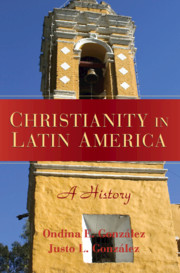Book contents
- Frontmatter
- Contents
- Preface
- Introduction
- 1 Foundations
- 2 The Arrival of Christianity
- 3 The Shaping of the Faith
- 4 Reform Movements
- 5 The Church in Turmoil
- 6 The Church's New Place
- 7 Protestant Immigration
- 8 An Expanding Protestant Presence
- 9 Catholicism after Vatican II
- 10 Pentecostalism and Autochthonous Movements
- 11 By Way of Conclusion
- Some Suggestions for Further Reading
- Sources Referenced
- Index
10 - Pentecostalism and Autochthonous Movements
Published online by Cambridge University Press: 05 June 2012
- Frontmatter
- Contents
- Preface
- Introduction
- 1 Foundations
- 2 The Arrival of Christianity
- 3 The Shaping of the Faith
- 4 Reform Movements
- 5 The Church in Turmoil
- 6 The Church's New Place
- 7 Protestant Immigration
- 8 An Expanding Protestant Presence
- 9 Catholicism after Vatican II
- 10 Pentecostalism and Autochthonous Movements
- 11 By Way of Conclusion
- Some Suggestions for Further Reading
- Sources Referenced
- Index
Summary
Early in the twentieth century, a movement began that would eventually sweep through much of Christianity. This is usually called the Pentecostal or Charismatic movement. These two words, “Pentecostal” and “Charismatic,” are often used interchangeably.
Etymologically, the first refers to the outpouring of the Spirit over the early disciples, as told in the second chapter of the book of Acts, which took place on the day of the Jewish feast of Pentecost. The second comes from the Greek word for “gift,” charisma, and refers to the gifts of the Spirit – particularly to extraordinary gifts such as speaking in tongues, healing, and prophecy. However, in this chapter we will not use those two words interchangeably. Since the word “Pentecostal” appears in the name of many a denomination, we will use it for those parts of the movement that did become denominations or independent churches and reserve the term “Charismatic” for those, Protestant as well as Catholic, who remained in their traditional denominations but emphasized the extraordinary gifts of the Spirit. It should also be noted that there are in Latin America thousands of independent congregations that, although not having the word “Pentecostal” in their name, are in fact Pentecostal.
Although there may have been similar events at roughly the same time in various parts of the world, historians usually place the beginning of Pentecostalism at the Azusa Street Mission in Los Angeles in 1906.
- Type
- Chapter
- Information
- Christianity in Latin AmericaA History, pp. 270 - 296Publisher: Cambridge University PressPrint publication year: 2007



